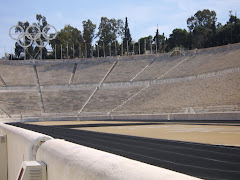This year's Oscar nominees yielded my worst-ever predictions ballot, with only seven correct picks.
But one correct selection was for music from "The Hateful Eight," inspiring a wave of Olympic memories.
I was so pleased to see Ennio Morricone win the Academy Award for best score. His walk to the stage instantly took me back to meeting and interviewing the Italian legend 10 years ago!
Morricone's from-the-heart acceptance speech translated as genuinely appreciative of the honor and of the company he keeps; it was classy he gave a shout-out to fellow nominee John Williams -- attending for his 50th Oscar nod -- who shared box seats for the ceremony.
Of course, Williams also had a cameo in that decade-ago conversation I shared with Morricone. Here's the story from that day that seems not so far in the past.
The date was February 13, 2006, and in Torino, Italy, working at the Olympics, I enjoyed the good fortune of a morning off to attend a five-ringed press conference featuring Morricone on stage.
The composer of more than 500 soundtrack songs and scores -- including the legendary "Dollars Trilogy" westerns, "Cinema Paradiso" and the haunting "Gabriel's Oboe" from "The Mission" -- was giving Italian media a preview of his concert to take place at the Olimpiadi Invernali Medals Plaza that evening (the same stage where then-recent "American Idol" winner Kelly Clarkson also performed, and where Whitney Houston attempted but struggled to sing a few nights later).
Hosted by the Torino Departments of Culture, Tourism and Film, the press conference was mostly for domestic reporters in the Piemonte Media Center. This was my very first "blogger Nick" press conference where I talked my way in sans credentials and senza blog (you read that right, this blog was not yet launched but partially inspired by the day's memorable events -- from those Games, I relied on a patient co-worker to relay daily updates as the word blog was barely in my lexicon).
Most of the press conference was in Italian, but the hosts were kind enough to deploy a translator, and when the media Q&A began, I was not shy to raise my hand and get called on by the one and only Ennio.
My question was a two-parter paraphrased here: Many Olympic films now have famous soundtracks, and the Olympics enjoy several soundtracks written by a famous film composers. Have you ever met ["Chariots of Fire" composer] Vangelis or John Williams, and were you, Mr. Morricone, ever invited to compose Olympic music or Olympic movie music?
Morricone maintained eye contact during my entire question, then he answered with a sincere gaze, which I captured on camera during his response (see photo at left).
To the surprise of many, including the translator beside me, Morricone responded in English, first thanking me for the question, then explaining that he did not meet Vangelis but he had met John Williams a few times.
Morricone said he did not compose music for sports movies, nor had he received an Olympic composing invitation, but that he was honored to perform for athletes that evening.
He said he vaguely recalled speaking with Williams not long after the 1984 Los Angeles Olympics (at which Williams' main Olympic themes debuted), but Morricone could not remember it being more than a brief conversation. They did not "compare notes" (I've wondered for the past 10 years whether Ennio knew this was a possible pun, and the extent to which it was expressed accidentally or on purpose). Next question!
I was stunned and could barely write his responses in my notebook fast enough.
He went on to take several more questions, at ease with a full room of microphones and cameras ... you know ... wait for it ... paparazzi.
He went on to take several more questions, at ease with a full room of microphones and cameras ... you know ... wait for it ... paparazzi.
As the Q&A wrapped up, Morricone was surprised to learn the event hosts planned to present him with a certificate (or diploma?) for his Olympic performance.
The composer graciously accepted the honor with sincere appreciation, just like his Oscar speech in Hollywood.
The press conference also yielded an etiquette lesson I've respected since 2006.
After the formal event wrapped up, I made my way to the stage to express gratitude to Morricone.
As we shook hands, and he thanked me for the question, I awkwardly held up my notebook to request his autograph.
He signed the book, but Morricone was none too pleased to learn I was both an international (non-Italian) "journalist" and a poser at that (!!!). (Sidebar: The notebook is buried somewhere in the Nick archive, but when it's located I will post a photo of the autograph.)
 To this day I have not asked for a single celebrity autograph (book signings notwithstanding) since Morricone's; rather, I've tried instead to enjoy the conversation or experience without the awkward-for-anyone approach with pen in hand.
To this day I have not asked for a single celebrity autograph (book signings notwithstanding) since Morricone's; rather, I've tried instead to enjoy the conversation or experience without the awkward-for-anyone approach with pen in hand.
In case officials at the Rome 2024 Olympic bid committee are tuned in and reading this, I think it's a matter or national interest and pride for the team to invite hometown hero Morricone to compose a bid project soundtrack that could carry them to an Italy Olympic Opening Ceremony in eight years.
It would be lovely to hear an Ennio sports soundtrack on the heels of his big night in L.A., and an Olympic theme could just be the perfect Morricone magnum opus.
Academy Award image via Oscars.com photo by Jeff Kravitz/FilmMagic.All other photos by Nicholas Wolaver copyright Nicholas Wolaver. Roma 2024 logo via Roma2024.org.















































